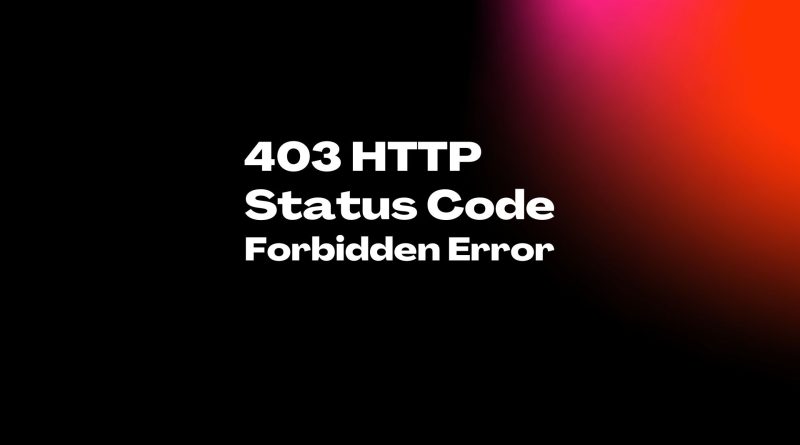403 HTTP (Forbidden error): What is it and how to fix it
Are you having trouble with your site displaying a 403 HTTP (Forbidden) error? You’ve come to the right place! A 403 Forbidden error is frustrating, but it can typically be solved quickly. In this blog post, we’ll walk through what causes this error and discuss how to troubleshoot and resolve it. By the end of reading our guide, you’ll have enough knowledge to understand why this commonly seen message appears on websites – and work out how to fix it.
What are the http status codes
HTTP status codes allow a webserver to communicate the outcome of an online request using Hypertext Transfer Protocol (HTTP). When you make a request, like when you type in an address into a web browser, your computer sends a request to the server containing that website. The server then responds with an HTTP status code which is a number that indicates whether or not the request was successful. For instance, a response of 200 signifies success and 404 indicates that the web page you are looking for does not exist. In addition, there are other status codes that further inform the response and help troubleshoot issues with connections, authentication, and more. Knowing how to interpret these codes can benefit developers by allowing them to quickly diagnose any problems they may be encountering while working on their projects.
What is 403 http status code
The 403 HTTP (Forbidden) status code indicates that the server understood the request but you aren’t allowed access to the resource. This can be due to insufficient permissions, authentication or other valid reasons. It is a way for a website to express that a certain directory or resource of their website is not accessible to visitors. This error message can be accompanied by an explanation denied access and should provide information on how users can gain access if they possess necessary credentials. Knowing what 403 errors are and what they mean helps in troubleshooting internet connection issues and other situations where credential restrictions are necessary.
Causes of 403 HTTP forbidden error code
You may come across the 403 Forbidden error when attempting to access a website for multiple potential reasons. A few of these include:
- Incorrect permissions: If you are attempting to access a resource that requires authentication or specific authorization, the results of this action may be an error 403: Forbidden.
- IP address blocking: If you’re receiving a 403 error when attempting to access some websites, your IP address could be blocked. In such cases, being unable to reach the website is expected, however if this doesn’t seem right and you think that your IP should have access, it’s possible that something else has been preventing its entry.
- Web server configuration: The web server may be set up to deny access to certain resources or obstruct particular categories of requests.
- Malware: It’s a possibility that any malware on your computer is obstructing access to specific sites if it has been infected.
- Firewall: It is possible that your firewall settings are preventing access to the website.
- Browser issues: It’s likely that an issue with your browser is behind the 403 error.
- Incorrect ownership or permissions on files: If you encounter a 403 error when attempting to open a certain file, it is very likely because the permissions for that particular file are set improperly.
- Incorrect .htaccess file: If you have set up an .htaccess file to regulate access on your website, it could be resulting in a 403 error.
- Incorrectly configured SSL certificates: If your SSL certificates on your website are not configured precisely, they might be responsible for a 403 error to occur.
- Overloading of the web server: When the web server is inundated with multiple requests at once, it may be overwhelmed and unable to fulfill them all resulting in a 403 error.
- Website maintenance: If the website is undergoing maintenance, it’s likely that you’ll see a “temporarily unavailable” message rather than a 403 error.
- Outdated cache: Have you encountered a 403 error while accessing an already-visited website? It’s likely due to the site’s outdated cache.
How to fix 403 error code
In order to quickly fix a 403 Forbidden error, here are some useful steps you can consider:
- Check the URL: Double-check the spelling of your URL and make sure you are attempting to reach the proper website.
- Clear your cache and cookies: If the current error is due to outdated cookies or cache, you can try solving this issue by deleting your web browser’s data. Doing so should help clear out any obsolete files that may be causing the problem.
- Check your permissions: Ensure that you possess the necessary permissions to gain access to the resource you’re attempting to utilize.
- Contact the website owner: If you still can’t access the website, why not reach out to the website owner? You may receive permission or find that there is a problem with their site.
- Check your firewall: To ensure you can access the website, double-check that your firewall is not blocking it.
- Check your browser: If the issue is only appearing in one specific browser, it may be a problem with that browser. Test accessing the website using an alternate program and see if you have any better luck; this should help you to determine whether the fault lies within your device or not.
- Try accessing the website from a different device: If you’re unable to access the website on your current device, we recommend trying a different one like a phone or tablet. This can help identify if the issue is still present or not.
- Check for malware: If you suspect your computer has been infected with malware, run a thorough scan to check for any potential problems.
- Check the web server configuration: As a website owner or with access to the web server, you can inspect the web server settings if any issues are underlying your 403 error.
- Restart your router: Encountering a 403 error when attempting to visit a website at home? It could be an issue with your router. Give rebooting your router a shot and verify if the problem still remains.
- Connect via VPN: A VPN connection has the potential to fix a 403 HTTP error and keep your sensitive data secure. Setting up a VPN server allow you to get around blocks or firewalls that would otherwise be an obstacle to getting past website errors
Similar http status codes
There are several HTTP status codes that are similar to the 403 Forbidden error code. Here are a few of them:
- 401 Unauthorized: This indicates that authentication from the user is required for this request to be fulfilled.
- 404 Not Found: An unsuccessful request was made as the requested resource is missing from the server.
- 405 Method Not Allowed: If you see this error, it typically means that the request method (GET, POST, etc.) is not authorized for the specified resource.
- 406 Not Acceptable: This error shows that the server is unable to generate a response suitable for the list of accepted values stated in the request’s headers.
- 407 Proxy Authentication Required: This mistake implies that the customer must validate itself with the proxy for successful communication.
- 408 Request Timeout: If this error appears, it means that the server did not receive a full request from the customer within its configured timeframe.
- 410 Gone: This error implies
See Also: HTTP 401 vs 403
All HTTP status codes by categories
Informational responses
(100 – 199)



